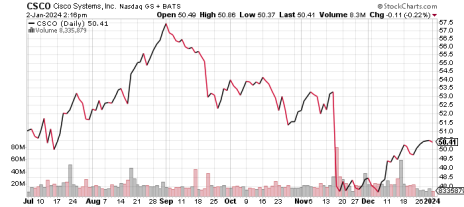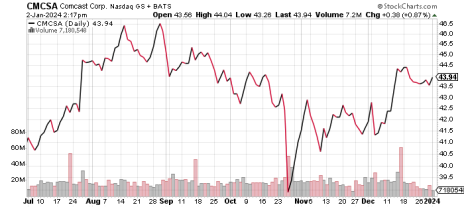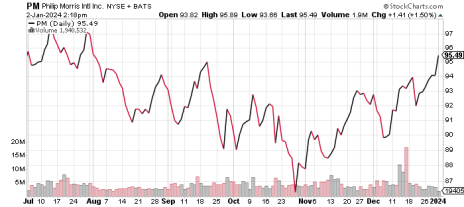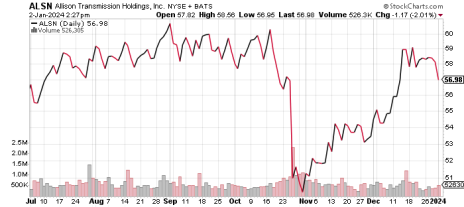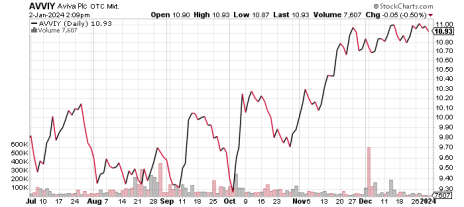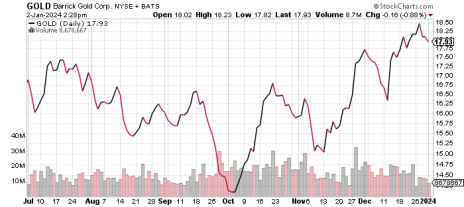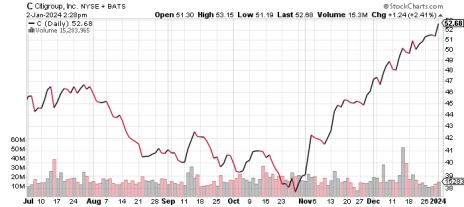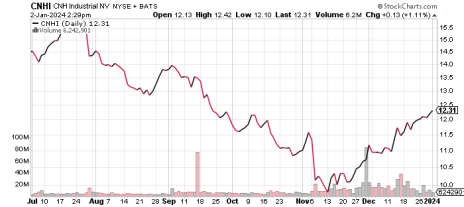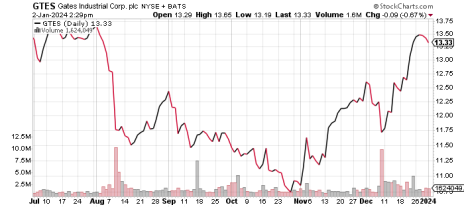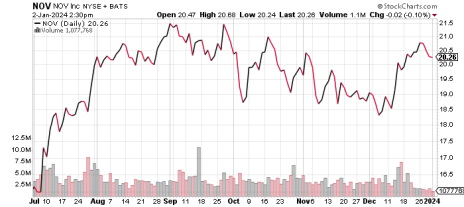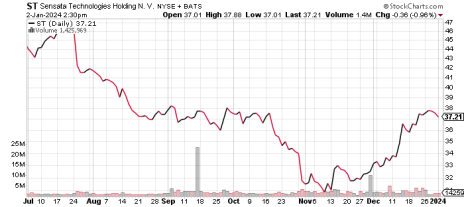2023 Review and Our Outlook for 2024
As investors know, the stock market as measured by the S&P 500 had a remarkable 2023. The index generated a total return of 26% (which includes dividends), unwinding nearly all of the previous year’s sell-off. The tech-heavy Nasdaq Composite rebounded 43%, a welcome response to 2022’s negative-33% return. The Dow Jones Industrial Average returned 16%, better than the long-term average of about 10%.
Since year-end 2019, just prior to the pandemic, markets have produced buoyant returns. The four-year annualized rates of return for the broad-based S&P 500 (+12%), Nasdaq Composite (+15%) and the more-like-the-broad-economy Dow Jones Industrial Average (+10%) have washed away the world-is-ending panic we all felt in March 2020.
The major driver of the S&P 500’s return in 2023 was the Magnificent Seven group of tech stocks (AMZN, MSFT, AAPL, GOOG, META, NVDA and TSLA). NVDA more than tripled during the year, while META nearly tripled and TSLA doubled. The weakest return of the group was AAPL at +48%. This collection of winners carried a combined weight of nearly 30% of the index. If the huge weighting effects were removed (by weighting all names in the index equally), the S&P 500 total return would have been cut nearly in half (to 14%).
Outside of the United States, returns were broadly similar to the Dow Jones Industrial Average and the equal-weighted S&P 500, reflecting their lack of Mag Seven equivalents.
Our recommendations included some strong winners for the year, like Allison Transmission (+40%), Comcast (+25%), Gates Industrial (+18%), Citigroup (+14%) and newly recommended CNH International (+13%). We had only one clunker (Sensata, down 7% for the year), although the shares remain 36% below our cost.
We sold some names for large since-inception gains in 2023, including Molson Coors (+90%), Dow (+66%), Arcos Dorados (+49%) and State Street (+27%). Yet, we also sold a major disaster recommendation: Big Lots (-82% loss). Some stocks were true bargains, and others like Big Lots looked like bargains but in reality, clearly were not. In 2024, we hope to have more stocks like our winners and fewer like our losers.
Our outlook for 2024 is for stocks to broadly produce a roughly 10% total return, in line with their historical average. The Mag Seven stocks could continue to surge, but we anticipate flat/modest gains at best for this elite group as their lofty AI-inspired valuations won’t likely be adequately supported by their ground-level fundamentals. Their pale returns should allow gains by the remaining 493 stocks to shine. Readers should keep in mind two of our favorite quotes about forecasts. The first, spoken by the linguistically creative baseball legend Yogi Berra, is that “predictions are difficult, especially about the future.” The second, from Warren Buffett, is that “… the only use for stock forecasters is to make fortune tellers look good.”
This new year will likely continue to feature strong roles by Washington, D.C. (particularly given the influence of the Fed and the upcoming presidential election) and by expansionary regimes in China, Russia, Iran and North Korea. Despite hopes for the better, we anticipate more disappointments on all of these fronts.
All-in, the pace of change across markets, the country and the world will continue to accelerate. One constant, however, is human nature. It never changes. While sometimes this constancy produces dark problems, it also has markedly and consistently improved the world and the daily lives of billions of people. As a contrarian investor, we also know that the constancy of human nature produces a reliable crop of out-of-favor stocks with real value. We repeat our comments from last year, in which “… consumers, companies and countries – amazing sources of ingenuity and resolve – work their magic to adapt to whatever curve balls are thrown at them. Our optimism is undaunted.” Onward to 2024.
Share prices in the table reflect Friday, December 29 closing prices. Please note that prices in the discussion below are based on mid-day January 2 prices.
Note to new subscribers: You can find additional color on past earnings reports and other news on recommended companies in prior editions and weekly updates of the Cabot Value Investor on the Cabot website.
Send questions and comments to Bruce@CabotWealth.com.
Today’s Portfolio Changes:
None
Portfolio Changes Since Last Month:
CNH Industrial (CNHI) – New BUY on November 30 via Alert
Comcast Corp (CMCSA) – Moving shares from BUY to HOLD
Allison Transmission (ALSN) – Moving shares from BUY to HOLD
Growth & Income Portfolio
Growth & Income Portfolio stocks are generally higher-quality, larger-cap companies that have fallen out of favor. They usually have some combination of attractive earnings growth and an above-average dividend yield. Risk levels tend to be relatively moderate, with reasonable debt levels and modest share valuations.
| Stock (Symbol) | Date Added | Price Added | 1/2/24 | Capital Gain/Loss | Current Dividend Yield | Price Target | Rating |
| Cisco Systems (CSCO) | 11/18/20 | 41.32 | 50.44 | 22.10% | 3.10% | 66 | Buy |
| Comcast Corp (CMCSA) | 10/26/22 | 31.5 | 43.97 | 39.60% | 2.60% | 46 | Hold |
| Philip Morris International (PM) | 9/18/23 | 96.96 | 95.53 | -1.50% | 5.40% | 120 | Buy |
| Stock | Current price | 2023 EPS Estimate | 2024 EPS Estimate | Change in 2023 Estimate | Change in 2024 Estimate | P/E 2023 | P/E 2024 |
| CSCO | 50.63 | 3.87 | 4.02 | 0.0% | 0.0% | 13.1 | 12.6 |
| CMCSA | 43.63 | 3.92 | 4.30 | -0.1% | -0.1% | 11.1 | 10.1 |
| PM | 95.20 | 6.08 | 6.49 | 0.0% | -0.1% | 15.7 | 14.7 |
Cisco Systems (CSCO) is facing revenue pressure as customers migrate to the cloud and thus need less of Cisco’s equipment and one-stop-shop services. Cisco’s prospects are starting to improve under a relatively new CEO, who is shifting Cisco toward a software and subscription model and is rolling out new products, helped by its strong reputation and entrenched position within its customers’ infrastructure. The company is highly profitable and generates vast cash flow (which it returns to shareholders through dividends and buybacks). Its announced deal for Splunk will drain most of its cash hoard but we see this as being replenished relatively quickly.
Cisco is buying Isovalent for about $650 million. Isovalent is an early-stage private company, backed by Cisco and several highly credible venture capital firms, that is deep in the weeds in developing cloud-native networking and security using open-source software. The company’s products look like a good strategic add-on to Cisco’s efforts to remain highly relevant across cloud-based computing. The deal price, equal to about 20x Isovalent’s revenues of around $30-35 million, is optically very high.
However, the right way to view this deal is as an example of Cisco buying research and development. Given this, it is difficult to assign a financial valuation to the transaction despite the visible price/sales multiple. A better approach: if Cisco were to spend $650 million on equivalent R&D over a five-year period, plus cover annual Isovalent operating losses of $20 million, the combined spending would equate to $150 million a year or about 2% of Cisco’s annual R&D budget of $7.6 billion. So, while the $650 million price for Isovalent seems high, on an R&D-equivalent basis it is small. Overall, this seems like a reasonable deal.
CSCO shares rose 1% in the past two weeks and have 30% upside to our 66 price target. Based on fiscal 2024 estimates, unadjusted for the Splunk acquisition, the valuation is reasonably attractive at 9.5x EV/EBITDA and 13.1x (on July 2024) earnings per share. BUY
Comcast Corporation (CMCSA) – Comcast is one of the world’s largest media and entertainment companies. Its properties include Comcast cable television, NBCUniversal (movie studios, theme parks, NBC, Telemundo and Peacock), and Sky media. The Roberts family holds a near-controlling stake in Comcast. Comcast shares have tumbled due to worries about cyclical and secular declines in advertising revenues and a secular decline in cable subscriptions as consumers shift toward streaming services, as well as rising programming costs and incremental competitive pressure as phone companies upgrade their fiber networks.
However, Comcast is a well-run, solidly profitable and stable company that will likely continue to successfully fend off intense competition while increasing its revenues and profits, as it has for decades. The company generates immense free cash flow which is more than enough to support its reasonable debt level, generous dividend and sizeable share buybacks.
There was no significant company-specific news in the past week.
Comcast shares fell 2% in the past two weeks and have 5% upside to our 46 price target. We recently moved the shares to Hold as they approached our price target. HOLD
Philip Morris International (PM) – Based in Connecticut, Philip Morris owns the global non-U.S. rights to sell Marlboro cigarettes, the world’s best-selling cigarette brand. Cigarettes comprise about 65% of PMI’s revenues. The balance of its revenues is produced by smoke-free tobacco products. The cigarette franchise produces steady revenues and profits while its smoke-free products are profitable and growing quickly. The upcoming full launch of IQOS products in the United States, a wider launch of the IQOS ILUMA product and the recent $14 billion acquisition of Swedish Match should help drive new growth.
The company is highly profitable, generates strong free cash flow and carries only modestly elevated debt (at about 3.2x EBITDA) which it will whittle lower over the next few years. The share valuation at about 13.5x EBITDA and 15.6x per-share earnings is too low in our view. Primary risks include an acceleration of volume declines and/or deteriorating pricing, higher excise taxes, new regulatory or legal issues, slowing adoption of its new products, and higher marketing costs. A strong U.S. dollar will weigh on reported results. While unlikely, Philip Morris could acquire Altria, thus re-uniting the global Marlboro franchise.
There was no significant company-specific news in the past week.
PM shares were flat in the past two weeks and have 26% upside to our 120 price target. The shares offer an attractive 5.5% dividend yield. BUY
Buy Low Opportunities Portfolio
Buy Low Opportunities Portfolio stocks include a wide range of value opportunities. These stocks carry higher risk than our Growth & Income stocks yet also offer more potential upside. This group may include stocks across the quality and market cap spectrum, including those with relatively high levels of debt and a less-clear earnings outlook. The stocks may not pay a dividend. In all cases, the shares will trade at meaningful discounts to our estimate of fair value.
| Stock (Symbol) | Date Added | Price Added | 1/2/24 | Capital Gain/Loss | Current Dividend Yield | Price Target | Rating |
| Allison Transmission Hldgs (ALSN) | 2/23/22 | 39.42 | 57.02 | 44.60% | 1.60% | 59 | Hold |
| Aviva (AVVIY) | 3/3/21 | 10.75 | 10.93 | 1.70% | 7.70% | 14 | Buy |
| Barrick Gold (GOLD) | 3/17/21 | 21.13 | 17.92 | -15.20% | 2.20% | 27 | Buy |
| Citigroup (C) | 11/24/21 | 67.28 | 52.96 | -21.30% | 4.00% | 85 | Buy |
| CNH Industrial (CNHI) | 11/30/23 | 10.74 | 12.36 | 15.10% | 3.20% | 15 | Buy |
| Gates Industrial Corp (GTES) | 8/31/22 | 10.72 | 13.38 | 24.80% | 0.00% | 16 | Buy |
| NOV, Inc (NOV) | 4/25/23 | 18.19 | 20.3 | 11.60% | 1.00% | 25 | Buy |
| Sensata Technologies (ST) | 2/17/21 | 58.57 | 37.32 | -36.30% | 1.30% | 57 | Hold |
| Stock | Current Price | 2023 EPS Estimate | 2024 EPS Estimate | Change in 2023 Estimate | Change in 2024 Estimate | P/E 2023 | P/E 2024 |
| ALSN | 58.11 | 6.95 | 7.20 | -0.20% | -0.90% | 8.4 | 8.1 |
| AVVIY | 10.89 | 0.37 | 0.45 | 0.30% | 0.00% | 29.2 | 24.1 |
| GOLD | 18.06 | 0.83 | 1.09 | -0.70% | -2.30% | 21.7 | 16.6 |
| C | 52.00 | 5.97 | 5.97 | -0.70% | 0.70% | 8.7 | 8.7 |
| CNHI | 12.40 | 1.69 | 1.50 | na | na | 7.4 | 8.2 |
| GTES | 13.65 | 1.25 | 1.37 | 0.00% | 0.00% | 11.0 | 9.9 |
| NOV | 20.56 | 1.42 | 1.72 | 0.00% | 0.00% | 14.5 | 12.0 |
| ST | 37.82 | 3.65 | 3.99 | 0.00% | 0.00% | 10.4 | 9.5 |
Allison Transmission Holdings, Inc. (ALSN) – Allison Transmission is a midcap manufacturer of vehicle transmissions. While many investors view this company as a low-margin producer of car and light truck transmissions that is destined for obscurity in an electric vehicle world, Allison actually produces no car or light truck transmissions. Rather, it focuses on the school bus and Class 6-8 heavy-duty truck categories, where it holds an 80% market share. Its EBITDA margin is sharply higher than its competitors and on par with many specialty manufacturers. And, it is a leading producer and innovator in electric axles which all electric trucks will require. The company generates considerable free cash flow and has a low-debt balance sheet. Its capable leadership team keeps its shareholders in mind, as the company has reduced its share count by 38% in the past five years.
There was no significant company-specific news in the past week.
ALSN shares fell 2% in the past two weeks and have 2% upside to our 59 price target. The shares offer a reasonable 1.6% dividend yield. Given the minimal upside, we recently moved shares of Allison Transmission to HOLD.
Aviva, plc (AVVIY), based in London, is a major European company specializing in life insurance, savings and investment management products. Amanda Blanc, hired as CEO in July 2020, is revitalizing Aviva’s core U.K., Ireland and Canada operations following her divestiture of other global businesses. The company now has excess capital which it is returning to shareholders as likely hefty dividends following a sizeable share repurchase program. While activist investor Cevian Capital has closed out its previous 5.2% stake, highly regarded value investor Dodge & Cox now holds a 5.0% stake, providing a valuable imprimatur and as well as ongoing pressure on the company to maintain shareholder-friendly actions.
There was no significant company-specific news in the past week.
Aviva shares were unchanged in the past two weeks and have 29% upside to our 14 price target. Based on management’s guidance for the 2023 dividend, which we believe is a sustainable base level, the shares offer a generous 7.8% yield. We anticipate a dividend increase for 2024. On a combined basis, the dividend and buybacks offer more than a 10% “shareholder yield” to investors. BUY
Barrick Gold (GOLD), based in Toronto, is one of the world’s largest and highest-quality gold mining companies. About 50% of its production comes from North America, with the balance from Africa/Middle East (32%) and Latin America/Asia Pacific (18%). Barrick will continue to improve its operating performance (led by its highly capable CEO), generate strong free cash flow at current gold prices, and return much of that free cash flow to investors while making minor but sensible acquisitions. Also, Barrick shares offer optionality – if the unusual economic and fiscal conditions drive up the price of gold, Barrick’s shares will rise with it. Given their attractive valuation, the shares don’t need this second (optionality) point to work – it offers extra upside. Barrick’s balance sheet has nearly zero debt net of cash. Major risks include the possibility of a decline in gold prices, production problems at its mines, a major acquisition and/or an expropriation of one or more of its mines.
There was no significant company-specific news in the past week.
Over the past two weeks, commodity gold rose 2% to $2,077/ounce, after nearly reaching $2,100 last week. Gold seems to be holding its $2,000+ pricing. Foreign central banks have stepped up their buying. But, financial investors including hedge funds continue to have low exposure to gold, based on government reports, which could be a bullish indicator.
Our view on gold prices avoids some of these technicals and is based on what we believe is a structural change to inflation levels (no longer at near zero). These changes include war, government spending, crime, oil prices and past-the-peak fading of the benefits of global free trade, in addition to a tight labor market. Aggregate inflation statistics include subcomponents which show starkly different pictures of pricing trends, and these trends can and have changed from month to month. Despite the favorable broad trend, there remains a reasonably good chance that inflation could remain above a 3% pace indefinitely. This would imply permanent 4-6% interest rates.
The 10-year Treasury yield ticked down to 3.93% from 3.98% two weeks ago, as investors continued to assume that the Fed would start a series of interest rate cuts next year.
The U.S. Dollar Index (the dollar and gold usually move in opposite directions) was unchanged at about 102.60.
Investors and commentators offer a wide range of outlooks for the economy, interest rates and inflation. We have our views but hold these as more of a general framework than a high-conviction posture. Investing in gold-related equities is a long-term decision – investors shouldn’t allow near-term weakness to deter their resolve.
Barrick shares were flat in the past two weeks and remain depressed despite gold prices above the $1,800 - $2,000 range, indicating that investors have no confidence in gold prices and little confidence in the company’s ability to generate higher cash flow. We note the surprising decline in earnings estimates for 2024. Barrick shares have 50% upside to our 27 price target. BUY
Citigroup (C) – Citi is one of the world’s largest banks, with over $2.4 trillion in assets. The bank’s weak compliance and risk-management culture led to Citi’s disastrous and humiliating experience in the 2009 global financial crisis, which required an enormous government bailout. The successor CEO, Michael Corbat, navigated the bank through the post-crisis period to a position of reasonable stability. Unfinished, though, is the project to restore Citi to a highly profitable banking company, which is the task of new CEO Jane Fraser. Investors have lost hope in Citigroup, creating an impressive bargain.
There was no significant company-specific news in the past week.
Citi shares rose 2% in the past two weeks and have 63% upside to our 85 price target. Since reaching lows in late October, Citi shares have surged 35%, highlighting the merits of holding onto stocks, and possibly adding to positions, on weakness rather than selling along with everyone else. The shares remain attractive as they trade at about 60% of tangible book value of $86.90. The dividend offers investors a 4.1% yield.
When comparing Citi shares with a U.S. 10-year Treasury bond, Citi offers a higher yield and considerably more upside price potential. Clearly, the Citi share price and dividend payout carry considerably more risk than the Treasury bond, but at the current valuation, Citi shares would seem to have a remarkably better risk/return trade-off. BUY
CNH Industrial (CNHI) – This company is a major producer of agriculture (80% of sales) and construction (20% of sales) equipment and is the #2 ag equipment producer in North America (behind Deere). Its shares have slid from their peak and now trade essentially unchanged over the past 20 years. While investors see an average cyclical company at the cusp of a downturn, with a complicated history and share structure, we see a high-quality and financially strong company that is improving its business prospects and is simplifying itself yet whose shares are trading at a highly discounted price. See our November 30 Alert and the December 5 Monthly letter for more color on our thesis.
CNH’s delisting from Euronext Milan is now effective. The company has completed $400 million of its $1 billion buyback in support of its Milan delisting.
CNH’s shares rose 4% in the past two weeks and have 21% upside to our 15 price target. The 3.2% dividend yield offers a worthwhile interim cash return. BUY
Gates Industrial Corp, plc (GTES) – Gates is a specialized producer of industrial drive belts and tubing. While this niche might sound unimpressive, Gates has become a leading global manufacturer by producing premium and innovative products. Its customers depend on heavy-duty vehicles, robots, production and warehouse machines and other equipment to operate without fail, so the belts and hydraulic tubing that power these must be exceptionally reliable. Few buyers would balk at a reasonable price premium on a small-priced part from Gates if it means their million-dollar equipment keeps running. Even in automobiles, which comprise roughly 43% of its revenues, Gates’ belts are nearly industry-standard for their reliability and value. Helping provide revenue stability, over 60% of its sales are for replacements. Gates is well-positioned to prosper in an electric vehicle world, as its average content per EV, which require water pumps and other thermal management components for the battery and inverters, is likely to be considerably higher than its average content per gas-powered vehicle.
The company produces wide EBITDA margins, has a reasonable debt balance and generates considerable free cash flow. The management is high-quality. In 2014, private equity firm Blackstone acquired Gates and significantly improved its product line-up and quality, operating efficiency, culture and financial performance. Gates completed its IPO in 2018. Following several sell-downs, Blackstone has a 37% stake today.
There was no significant company-specific news in the past week.
Gates shares rose 8% in the past two weeks and have 17% upside to our 16 price target. BUY
NOV, Inc (NOV) – This high quality mid-cap company, formerly named National Oilwell Varco, builds drilling rigs and produces a wide range of gear, aftermarket parts and related services for efficiently drilling and completing wells, producing oil and natural gas, constructing wind towers and kitting drillships. About 64% of its revenues are generated outside of the United States. Its emphasis on proprietary technologies makes it a leader in both hardware, software and digital innovations, while strong economies of scale in manufacturing and distribution as well as research and development further boost its competitive edge. The company’s large installed base helps stabilize its revenues through recurring sales of replacement parts and related services.
We see the consensus view as overly pessimistic, given the company’s strong position in an industry with improving conditions, backed by capable company leadership and a conservative balance sheet.
There was no significant company-specific news in the past week.
The price of West Texas Intermediate (WTI) crude oil fell 3% to $71.65/barrel. Tensions in the Middle East are rising as Tehran has sent a destroyer to the Red Sea. Oil production in the United States has returned to its prior high, which has offset the recent extension of the OPEC+ production cuts.
Outcomes in wars are unpredictable. It would seem that the potential for sharp oil price volatility is higher with the increasingly complicated game of shifting geopolitical and economic alignments. A major new catalyst, in addition to all of the others, would be export or production cuts from the Middle East if Iran became directly or even explicitly indirectly involved (including if the U.S. restores its sanctions). Also, American sanctions on Venezuelan oil may return, which would provide at least modest support for oil prices.
The price of Henry Hub natural gas fell 7% to $2.38/mmBtu (million BTU). Mild temperatures and strong oil production (natural gas is often a byproduct of oil production) suggest, at the moment, that natural gas will be plentiful this winter.
NOV shares rose 1% in the past two weeks and have 22% upside to our 25 price target. The dividend produces a reasonable 1.0% dividend yield. BUY
Sensata Technologies (ST) is a $3.8 billion (revenues) producer of nearly 47,000 highly engineered sensors used by automotive (60% of revenues), heavy vehicle, industrial and aerospace customers. About two-thirds of its revenues are generated outside of the United States, with China producing about 21%. Investors undervalue Sensata’s durable franchise. Its sensors are typically critical components that generally produce high profit margins. As the sensors’ reliability is vital to safety and performance, customers are reluctant to switch to another supplier that may have lower prices but also lower or unproven quality. Sensata has an arguably under-leveraged balance sheet and generates healthy free cash flow. The relatively new CEO will likely continue to expand the company’s growth potential through acquisitions. Electric vehicles are an opportunity as they expand Sensata’s reachable market. Our Sensata investment remains an underperforming (from a business fundamentals perspective) work in progress.
There was no significant company-specific news in the past week.
The shares will likely remain weak or stagnant for the near-term due to the company’s weak fundamentals and average leadership. We will wait for a favorable change in investor sentiment but are poised to pull the plug. ST shares rose 3% in the past week and have 51% upside to our recently reduced 57 price target. HOLD
Disclosure: The chief analyst of the Cabot Value Investor personally holds shares of every Recommended security. The chief analyst may purchase or sell recommended securities but not before the fourth day after any changes in recommendation ratings have been emailed to subscribers.
Strong Buy – This stock offers an unusually favorable risk/reward trade-off, often one that has been rated as a Buy yet the market has sold aggressively for temporary reasons. We recommend adding to existing positions.
Buy – This stock is worth buying.
Hold – The shares are worth keeping but the risk/return trade-off is not favorable enough for more buying nor unfavorable enough to warrant selling.
Sell – This stock is approaching or has reached our price target, its value has become permanently impaired or changes in its risk or other traits warrant a sale.
Note for stock table: For stocks rated Sell, the current price is the sell date price.
The next Cabot Value Investor issue will be published on February 6, 2024.
